mobile View, to the German Version tap the flag


- since 1979 Autonomous Region of Spain
- own names:
– Basqe: Euskadi
– Spanish: País Vasco
– French: Pays Basque
• Flag
• Historical and other Flags
• Meaning/Origin of the Flag
• Coat of Arms
• Historical Coats of Arms
• Meaning/Origin of the Coat of Arms
• The Basque Territories "Euskal Herria"
• Map of the autonomous regions of Spain
• Numbers and Facts
• History
• Origin of the Country's Name
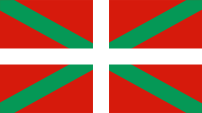
Flag of Basque Country,
ratio = 13:25,
Source, by: Flags of the World






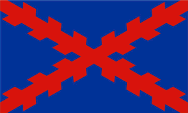
18th-19th century,
Flag of the Dominion of Biskaya,
Source, by: Flags of the World



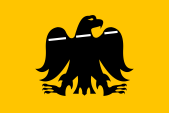
"Arrano Beltza",
The Black Eagle,
ratio = 2:3,
Source, by: Wikipedia (DE)




The flag of the Basque Country is plain red with a white St. George's Cross and a green St. Andrew's Cross. The colour red represents the blood spilled during the struggle for freedom, green symbolises the Holy Oak of Guernica and the white cross represents the Catholic faith. The flag is called "Ikkurina" and has been in use since 1894.
It was officially introduced on 8th of Oktober in 1936 and was used until September 1937. After that, under the rule of General Franco, it was banned. After Franco's death (20th of November in 1975), its use was no longer punished from 21st of September in 1976 and officially permitted from 19th of January in 1977. The flag was officially reintroduced on 18th of December in 1978 and was taken over on 22nd of December in 1979 in connection with the Statute of Autonomy for the Basque Country. The colours of the flag are laid down in "Art. 3 (1979) of Organic Law 18/12 of December 1980 on the Statute of Autonomy of the Basque Country", last amended on 10th of October in 2005. They are indicated as follows: Green = Pantone 347, Red = Pantone 485. Flags with a green St. Andrew's Cross appeared very early in the history of the Basques. The county of Bizkaia first adopted a red flag, the white cross appears in the coat of arms of Bizkaia, as does the Sacred Oak. Another important flag of the Basques is the "Arrano Beltza", the black eagle on a golden background. It goes back to the seal of King Sancho III. and is often depicted asymmetrically. The asymmetry is usually indicated or reinforced by an oblique golden or white line in the upper part of the eagle. Each Basque province (in Spain) or region (in France) has its own flag. In France, however, these flags are not official. France is not (any longer) divided into historical regions but into arbitrarily defined departments, which do not have their own flags.
Source: Wikipedia (ES),
Wikipedia (DE),
Flags of the World,
Volker Preuß

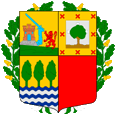
since 1986,
Coat of arms of Basque Country,
Source, by: Wikipedia (ES)

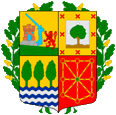
1936–1937, 1979–1986,
Coat of arms of Basque Country,
Source, by: Wikipedia (ES)

The today’s coat of arms of the Basque Country was introduced on 2nd of November in 1978. It shows a quartered shield. In field 1 a castle armed with a sword warding off a red lion (Araba), in field 2 the Heilige Oak of Guernica, in the background a white cross, golden bordered with eight small red diagonal crosses (Bizkaia), in field 3 blue and white wave lines and three trees (Gipuzkoa). The field 4 is single-coloured red. It stands for Nafarroa (Navarra). In that field was to see the whole heraldry of Nafarroa until 1986, but the government of that region intervened in the year 1982 against the use of its symbolism. Behind the shield a wreath of oak twigs which is bonded by green and white ribbons.
Source: Wikipedia (ES),
Volker Preuß

The regions where Basques live in, 1st) in Spain: Basque Country, Navarra, 2nd) in France: Lower Navarra, Soule and Labourd are summarized by the Basques with the word "Euskal Herria".
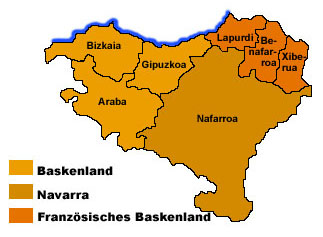
Map: Volker Preuß
Nafarroa (Spanish: Navarra):
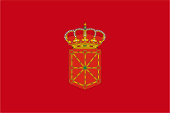
Navarra,
Autonomous Region of Spain,
(more Info? → click or tap here)
Bizkaia (Spanish: Vizcaya):
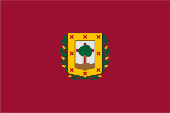
Biscaya,
Province of Basque Country,
2.217 km², 1.149.344 Ew./inh. (2022),
Capital: Bilbo (Bilbao),
Source, by: Wikipedia (ES)
Gipuzkoa (Spanish: Guipúzcoa):
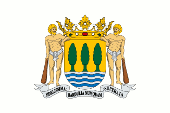
Gipuzkoa,
Province of Basque Country,
1.980 km², 724.418 Ew./inh. (2022),
Capital: Donostia (San Sebastian),
Source, by: HansenBCN, Public domain, via Wikimedia Commons
Araba (Spanish: Álava):
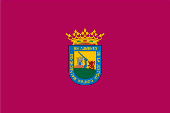
Álava,
Province of Basque Country,
3.032 km², 334.412 Ew./inh. (2022),
Capital: Vitoria (Gasteiz),
Source, by: Wikipedia (ES)
Lapurdi (French: Labourd):
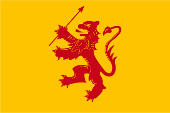
Labourd,
Basque region in France,
858 km², 205.000 Ew./inh.,
Capital: Ustaritz,
Source, by: Wikipedia (FR)
Benafarroa (frz. Basse-Navarre):
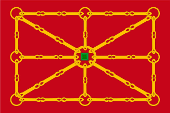
Niedernavarra,
Basque region in France,
1.323 km², 31.750 Ew./inh.
Capital: Saint-Jean-Pied-de-Port,
Source, by: Wikipedia (ES)
Xiberua (French: Soule):
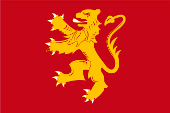
Soule,
Basque region in France,
785 km², 15.000 Ew./inh.
Capital: Mauléon-Licharre (Maule),
Source, by: Wikipedia (ES)

The autonomous Regions of Spain:
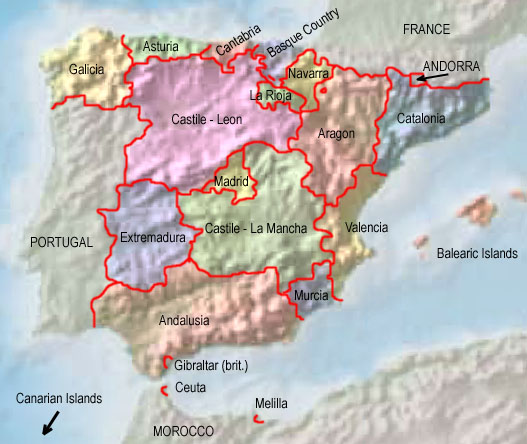
Source: Freeware, University of Texas Libraries, modyfied by: Volker Preuß

Area: 2.793 square miles
Inhabitants: 2.222.164 (2023), mostly Basques
Density of Population: 796 inh./sq.mi.
Capital: Gasteiz (Vitoria), 249.176 inh. (2018)
official Languages: Spanish (Castilian), Basque (in three regional dialects)
Currency: Spanish (Euro) currency
Time Zone: GMT + 1 h
Source: Wikipedia (EN)

Antike · settlement by the iberian tribe of the Basques (Vascons)
ca. 600 B.C. · immigration of Celts, the Vascons become by mix with the Celts to Celtiberians, the today's Basques
218–201 B.C. · Second Punic War, the Roman Empire acquires the possessions of Carthago in Iberia, subjugation of whole Iberia until the year 19 B.C., in Basque Country partially Roman settlement, partial romanization
74 B.C. · foundation of Pompeiopolis Town (Pamplona) by the Roman General Sextus Pompeius
ca. 400 A.D. · Great Transmigration (Migration Period), immigration of Alans, teutonic Suebs and Western Goth, the Basques are able to preserve their independence
580 · Leovigild the king of the Western Goth conquers and submits the Basques, the today’s Basque Country becomes a part of the Empire of the Western Goth, Leovigild founds the town Vitoria ("victory") beside the Western Goth castle Gasteiz, many Basques flee via the Pyrenees Mountains and settle in the Frankish Gascogne (from there the name)
78–680 · Wamba the king of the Western Goth conquers and submits the Basques in the Gascogne
711–714 · annihilation of the Empire of the Western Goth by from northern Africa coming Arabs, the Western Goth retreat to Asturia, Cantabria and Basque Country, the Arabs are not successful in the conquest of Asturia, Cantabria and Basque Country
778 · the Frankish Empire under Carl the Great conquers the foreland of the Pyrenees Mountains, establishment of the Spanish Mark in the foreland of the Pyrenees Mountains, but defeat against the Basques in the Valley of Ronceval (Roncesvalles)
795–812 · re-establishment of the Spanish Mark by Carl the Great and his son Ludvig the Pious
812 · liberation of Pamplona Town from the Arabs by the Basques, establishment of the Kingdom of Pamplona
816–851 · reign of Iñigo Arista over Pamplona
827 · nsuccessful revolt of the der Basques against the Frankish Empire, Pamplona becomes a part of the Spanish Mark as a county
905 · Sancho Garcia, elected to the Count of Navarra (County of Pamplona), nominates itself to the King of Navarra and enforces the independence from the Frankish Empire
905–925 · King Sancho of Navarra liberates the areas northern Ebro River, parts of the today's Aragonia and parts of Castile from the Arabs
925 · death of King Sancho
1001–1035 · times of the rule of Sancho III. (the Elder), after his death the kingdom becomes shared under his four sons: Garcia earns Old-Navarra and Biscaya, Ferdinand earns parts of Castile, Ramiro earns Aragonia, Gonzales earns Tudela
1076 · king Sancho Ramiro of Aragonia stürzt king Sancho IV. of Navarra and unites both empires
1134 · death of king Alfons I., Navarra becomes an independent kingdom again
1200 · ceding of territories to Castile
1234 · death of king Sancho VII. of Navarra, with this fact vanishes the dynasty of Sancho in Navarra, the heritage goes to Thibaut of Champagne
1285 · Johanna of Champagne, the last heiress of the house, marrys king Philipp IV. (the Pretty) of France from the house of the Kapetings
1328 · death of king Ludvig X., vanish of the main-line of the Kapetings, Johanna II. the daughter of Ludvigs X. inherits Navarra, her consort Philipp III. Count of Evreux becomes in this way King of Navarra
1332 · ceding of territories to Castile
1375–1379 · war of Navarra (under Carl II. [the Evil], son of Philipp III.), Wales and Aragonia against France and Castile, Navarra becomes ravaged
1379 · ceding of territories to Castile
In this way were ceded to Castile the then counties and today’s Basque provinces of Araba, Biskaya and Gipuzkoa between 1035 and 1379, they remain until 1979 provinces of Castile/Spain. Navarra – then as a state of Basque nationality – exists further, for more history data about Navarra click here. The Basques in the provinces continued always special rights, so named "Fueros", which expressed their independence facing Castile/Spain.
1805 · the Fueros become limited
1832 · the Fueros should become fully abolished
1833 · the until that point in time in Spain existing partial kingdoms and regions become divided in provinces, the Reign of Biscaya in the provinces of Vizcaya (Bilbao), Guipúzcoa (San Sebastián) and Álava (Vitoria)
1833 · Basque revolt against the Spanish government, the Basques join in the civil war (Carlist Wars) the party of Don Carlos
1840 · peace treaty of Vergara, the Fueros become confirmed
1841 · the Fueros become limited again
1843 · Spain grants Navarra and the Basque Provinces trade free from customs
1844 · the constitution from before 1805 becomes reestablished, but Spain ignores it more and more
1872–1876 · Basque revolt against the Spanish government becomes suppressed
1876 · the Fueros become once more and very strong limited
5th of October 1936 · formation of an "Autonomous Region od Basque Country" in the provinces of Biskaya and Gipuzkoa, the Basque province of Araba comes in the civil war under control of the troops of General Franco
19th of June 1937 · Bilbao becomes conquered by the troops of General Franco
23th of October 1937 · whole Basque Country becomes conquered by the troops of General Franco, autonomy ends
1959 · foundation of the ETA (Euzkadi Ta Askatasuna)
20th of November 1975 · death of General Francisco Franco
1978 · new constitution, Spain becomes a parliamentary constitutional monarchy
22th of December 1979 · Basque Country gets the statute of autonomy within Spain (by summary of the provinces of Vizcaya, Guipúzcoa and Álava), establishment of the "Autonomous Community of Basque Country", ETA rejects the statute and demands independence
Source: Wikipedia (ES),
World Statesmen,
RetroBib Retrobibliothek,
Volker Preuß

The name "Basque Country" has ist roots logically in the people of the Basques, which were named "Vascons" in the antiquity. The Basques call themselves "Euskaldunak" and the Basque Country "Euskadi". The regions where Basques live in, 1st) in Spain: Basque Country, Navarra, 2nd) in France: Lower Navarra, Soule and Labourd are summarized by the Basques with the word "Euskal Herria". The French Basque Country is called "Iparralde", and the Spanish Basque Territory (Autonomous Community of Basque Country and Autonomous Community of Navarra) is called "Hegoalde".
Source: Wikipedia (ED),
Volker Preuß


![]()





















